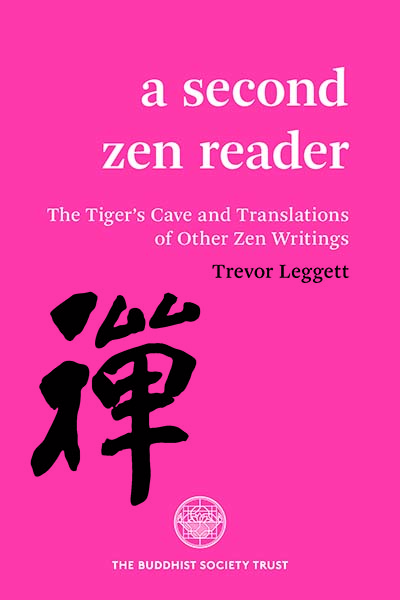A Second Zen Reader

Book description
A Second Zen Reader gives a fascinating insight into Zen life through a selection of texts translated from the Japanese by Trevor Leggett. The main texts are ‘The Heart Sutra’ with a commentary by Abbot Obora of the Soto Zen sect and ‘Yasenkanna’ an autobiographical piece by Hakuin, the great eighteenth century Zen master. Other texts include stories such as ‘The Tiger’s Cave’ and two discourses by Rosen Takashina, the late primate of Soto Zen.
Paperback published by the Buddhist Society in association with TLAYT
ISBN 9780901032515
Price £12.99
Book extract
SILLNESS IN ACTION Stillness in the midst of action is the fundamental principle of Zazen (sitting in meditation). Some people think of Zazen as a sort of monopoly of the Zen sect, but the sect certainly has no monopoly of it. Zazen is the basis of the universe. Heaven and earth sit in meditation, every object sits in meditation. Knowing nothing of the Zen sect, all things are performing their meditation. What is called Zazen means to live at peace in the true basis of the universe, which is stillness. Movement is a secondary attribution: stillness is the real condition. Out of stillness comes all activity. For instance, the water of the ocean, when disturbance of wind ceases, at once goes back to the state of calm; the grass and trees, when the cause of agitation dies away, become as it were calm. These things always return to rest in the stillness which is their true nature. And this is the principle of Zazen. In nature there are day and night; when the sun sets gradually there is a hush, until what is called the dead of night when all is still as if a current of water had ceased to flow. This is Zazen of nature. As with everything else, so with man. Working by day, we sleep at night. Falling into deep sleep, men forget the existence of self and are absolutely at rest. This is a state of what is called in Zazen ‘body and mind loosed and dropped away’. In nature the counterpart of the restless action of day is the absolute stillness of night, and to abide in that is the principle of Zazen. In this sense everything naturally practises Zazen. I may know nothing of Zazen, yet if I know what it is to sleep in bodily and mental relaxation then all unconsciously the benefits of Zazen rain upon me. The Zazen of the Zen sect is to seek this way of stillness in the midst of activity. The method is to bring to stillness the mental activities, based on illusion, and conform to the stillness which is the fundamental nature of the mind. When it is attained in Zazen, the result is called Satori or realization. Zazen is practice of infinity, conforming to the infinity which is the principle of the universe.
Book Review
The Tiger’s Cave (A Second Zen Reader), translations. from Japanese Zen texts
The Indian mind is Aryan, like our own. We are able to understand it, and the Indian classics reveal their secrets readily to us. The Japanese mind is baffling to us. Zen is most baffling of all. The Zen saying that prefaces this book, ” If you want a tiger’s cub, you must go into the tiger’s cave”, is readily understandable. But do the contents of the book in any way resemble a tiger’s cave? They are a rich mixture of anecdotes and moral tales with a commentary on the Heart Sutra, one of the most difficult texts of Mahayana Buddhism. This very short text opens ”O disciple Shariputra, form is not different from emptiness, emptiness is not different from form. Form is emptiness and emptiness is form’’….Subtlety and paradox are characteristic of Japanese thought. If you find this intriguing, this is your book.
V.G.W.
Yoga
Every page of this profoundly erudite book is written with compelling insight by the well known author of books on Zen, former Head of the BBC Japanese Service and holder of the Sixth Dan in Judo, who spent many years with Japanese masters.
The title, The Tiger’s Cave, is taken from one of the stories illustrating the modern Zenic approach to life in Japan. There are five sections, each one reflecting in depth a different emphasis of a particular mater or school of Zen…
However the most important section is the first, an inspired and inspiring commentary on the ‘Heart Sutra’ by a Soto Zen abbot…
The Theosophical Journal May/June 1978
A sparse but valuable sampling of Japanese Zen texts includes two major works: ‘The Heart Sutra’, the major principles of Zen Buddhism, and the autobiography of the eighteenth century Zen master Hakuin that details an archetypal Zen crisis. Shorter selections include several twentieth-century poems and the famous maxims of the nineteenth-century sage Takamori Saigo.
CF
Zen Buddhism